Snowmobile vs ATV For Ice Fishing (Which Is Better?)
UPDATED 18 MAY 2023
by Robert Ceran
Are you wondering whether a snowmobile or ATV is better for ice fishing?
While every ice angler knows that a motorized vehicle can be extremely helpful for hauling heavy ice fishing equipment onto the ice, there are two camps when it comes to choosing whether a snowmobile or ATV is the better choice for this.
So if you’re not sure which one is better for you, and need to make a decision before you can fish on the ice, read on.
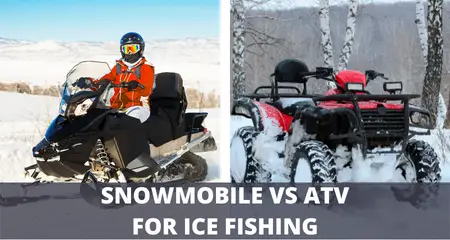
In this article we’ll compare the pros and cons of snowmobiles and ATVs side by side, and will also dissect their key features, in order to help you decide which one is best for your purposes.
Is an ATV or snowmobile better for ice fishing?
While snowmobiles are cheaper and better for driving on ice with deep snow, ATVs are more versatile, can be fitted with tracks, and can be used on and off the ice during all seasons.
So which one is better for you depends on several factors, including your budget, personal preference, and the amount of snowfall in your area.
If you’re on a small budget, then a second hand snowmobile is probably the top choice for you, as you can get one as cheap as two thousand dollars.
An ATV, on the other hand, is bigger and can carry more load, and it can be used both during the summer and winter, which makes it worth the higher cost for some anglers.
If you live in an area with a long ice fishing season, it may even be worth getting both types of ice fishing vehicles – an ATV for early ice and phases of light snowfall, and a snowmobile for days with deep snow cover.
Snowmobile: pros and cons for ice fishing
Let’s take a look at the key advantages and disadvantages of snowmobiles when it comes to ice fishing.
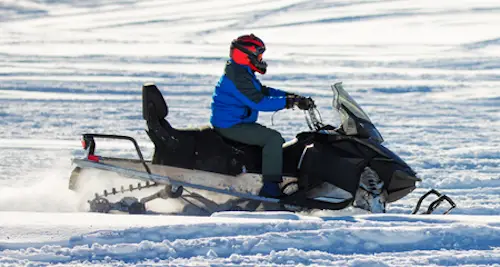
Pros
The main advantages of snowmobiles are:
- Better in deep snow
- Better for slush
- Relatively inexpensive
- More power
- Faster
- Lighter
Let’s dive into the details and examine these key strengths of snowmobiles.
Since snowmobiles are designed to be used on snow, they work great for driving on pretty much any kind of snow, from light powder snow to deep midwinter snow.
They also work for driving on bare ice (though you have to make sure your snowmobile is fan cooled if you wnat to drive it on ice without snow – more on that below).
In other words, you can use a snowmobile straight out of the box for your next ice fishing trip, without having to modify it.
Another advantage that comes hand-in-hand with their snow-friendly design is that snowmobiles generate more power than ATVs, which is ideal if you need to pull a big ice fishing sled through the snow.
The extra power of snowmobiles is due to their wide chain, which provides more traction in the snow.
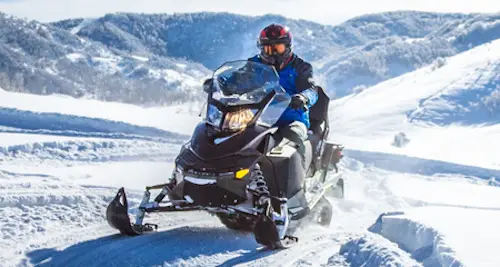
Also, due to their extra power and the skis at their front end, snowmobiles are also significantly faster on snow than ATVs.
This can make an important difference if you need to drive over large distances in order to reach your ice fishing spot.
Finally, snowmobiles are also more lightweight than ATVs (weighing about 100 pounds less than ATVs on average). This can be an important factor if you want to minimize the weight of your vehicle on thin ice.
However, if ice thickness is a concern, always make sure you follow the regulations of your local authorities with respect to what vehicles are allowed on the ice at any given time of the ice fishing season.
Due to their lightness of weight and slender build, you can also transport snowmobiles more easily on the back of a pickup truck or trailer. In fact, a broad trailer can accommodate two snowmobiles side by side, while an ATV is too wide for this.
If you do decide to go with a snowmobile, I recommend getting one with an electric start, as well as a reverse gear. While these aren’t 100% necessary, they will make your life a lot easier on the ice.
Cons
The main disadvantages of of snowmobiles are:
- You need a fan cooled snowmobile for ice
- Can only be used in winter
Since liquid cooled snowmobiles make use of the snow to cool their motor, you can’t use a liquid cooled snowmobile when driving on bare ice, since it will overheat very quickly.
Instead, you should use a fan-cooled snowmobile on ice, which comes with slightly lower power and fuel-efficiency.
This means that if you already have a snowmobile for trail riding in the snow, it may not be suitable for ice fishing if there is not enough snow on the ice. You need at least 6 inches of snow on the ice to use a liquid-cooled snowmobile.
So if you want to get a snowmobile specifically for ice fishing, then it’s definitely better to get a fan cooled sled, as that will allow you to go out on the ice even if there isn’t much snow on it.
An alternative you might want to try is installing ice scratchers on your snowmobile, which scrape the ice and throw small pieces of ice onto the heat exchanger, thus replacing the need for snow to cool it.
That brings us to another important disadvantage of snowmobiles: since they are specifically designed for use on snow, they can only be used in winter, and become more or less useless in summer.
In other words, you’ll be storing your snowmobile for the largest part of the year, and will only be using it for a few months every ice fishing season.
ATV: pros and cons for ice fishing
Now let’s take a look at the key advantages and disadvantages of ATVs when it comes to using them for ice fishing.
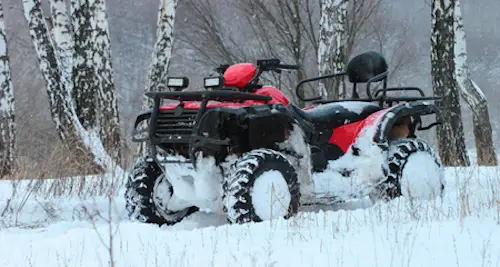
Pros
The main advantages of ATVs are:
- Can be used in summer and winter
- More versatile
- Can be fitted with snow tracks
- Greater stability
- More stowing space
The most obvious advantage of ATVs is that they can be used all year round, both on snow and ice, as well as on dry land.
This versatility is due to the fact that you can use them with regular wheels throughout summer and early winter, and with snow tracks when the snow gets thick in winter.
This means you can put your ATV to good use in the warm season, instead of having to stow it away until the next winter season. Personally, I like to ride off-road trails with my ATV in summer, and then use it for ice fishing in winter.
But in order to use an ATV in deeper snow, you do need to fit it with tracks, or you’ll get stuck instantly.
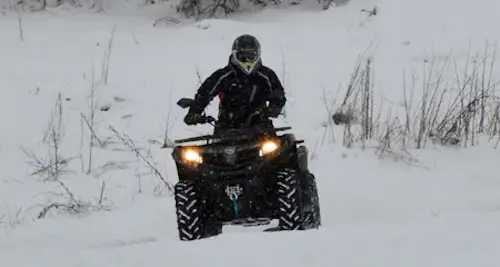
However, the ability to switch between wheels and tracks makes a quad more versatile than a snowmobile. So much so that it can be used in almost all terrains and in most types of weather.
You can also use a quad as a snow plow in your front yard (which might help you to justify the purchase to your significant other).
Finally, due to their wider build, ATVs are more stable than snowmobiles, and are almost impossible to tip over.
Their wide build also means that ATVs come with more stowing space, allowing you to carry pretty much all the gear you need for ice fishing, including your auger, rods, reels, electronics, etc. on the quad itself without having to tow a sled behind it.
I like to use an auger mount to carry my ice auger on the back of the ATV, while I’ve found that a snowmobile is a little too narrow for this purpose, and tends to get out of balance when carrying an ice auger mounted sideways across the back.
Cons
The main disadvantages of ATVs are:
- Can’t be used in deep snow without tracks
- Relatively expensive
- Need to buy tracks separately
- Less power in snow
- Larger and heavier
The biggest disadvantage of quads is that they can’t be used in deep snow without changing your wheels to tracks.
If you live in an area without too much snowfall, you might be fine with a regular ATV for most of the hardwater season.
If trails are plowed on the ice regularly, an ATV is able to drive well on these even if the snow is too thick elsewhere.
And while the ability to swap your wheels out with tracks makes quads incredibly versatile, this does represent a significant additional expense, and requires several hours of work to implement.
But even if you switch your ATV to tracks, it will generate less power in the snow than a snowmobile. This is because its narrower tracks provide less traction in the snow.
This isn’t really a problem unless you need to tow a heavy ice fishing sled over the ice, in which case a snowmobile is probably better for you.
Finally, the fact that ATVs are heavier and wider than snowmobiles also makes them somewhat harder to transport.
How good are ATVs on ice and snow?
ATVs with wheels can drive well on bare ice, as well as on ice with a few inches of snow. You can drive them quite fast under these conditions, although you’ll probably get a little drift when you change direction or pump the brake.
However, if there is more than about 10 inches of snow on the ice, an ATV will get stuck almost instantly, and you need to replace the wheels with tracks if you still want to continue using your ATV on the ice.
If there is thick snow on the ice, but trails have been cleared of snow, you can still use a regular ATV with wheels to drive on the trails, but without being able to stray away from them.
ATVs that are fitted with tracks can drive well on any kind of ice, even if it is covered with thick snow, providing the ice is thick enough to hold small vehicles.
How do ATVs with tracks compare to snowmobiles on ice?
ATVs fitted with snow tracks perform equally well to snowmobiles on ice, or when driving over deep snow. In fact, due to their wider build, they are more stable than snowmobiles in deep snow, and don’t tip over as easily.
A slight caveat here is that snowmobiles can go a lot faster over snow than ATVs with tracks. So if you need to cover a lot of ground in a short period of time, then a snowmobile instead of an ATV would be a better option for you.
Finally, the main disadvantage of using tracks on an ATV is that you have to purchase a track kit separately, and mounting it on your ATV requires a significant effort.
How much do ATV tracks cost?
ATV track systems typically retail between $3000 to $5000. Depending on your specific model of ATV and the tracks you choose, you may also need a mounting bracket and a clutch kit to go along with this.
And while this definitely isn’t a cheap buy, getting a track kit is still cheaper than buying a new snowmobile.
However, if you decide to get a used snowmobile, you should be able to get a good one for the same amount of money, or less, than it would cost you to get a track kit.
Finally, it’s also worth noting that you can also use ATV tracks on marshy ground, so they might come in handy during the summer as well as the winter.
Final remarks
This concludes our article comparing the pros and cons of an ATV vs snowmobile for ice fishing.
As you can see both of these have their strengths and weaknesses, and both of them can be used successfully on the ice.
In fact, some avid ice anglers have both an ATV and snowmobile, and use the ATV as long as there’s a thin layer of snow on the ice, and only bring out their snowmobile when there is a lot of snow, and the snow gets deeper than 1 foot.
